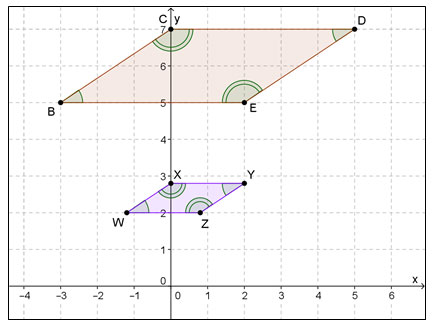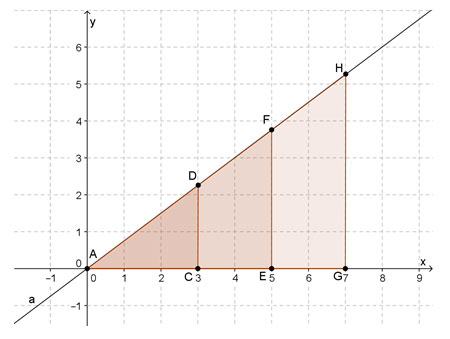In this section, you will use dilations in order to generate similar figures.
![]() Use the interactive below to dilate ΔABC. Click and drag on the slider to dilate ΔABC to create ΔDEF. The number on the slider indicates the scale factor used to generate the dilation. Use the interactive to complete the table that follows. Use the table to answer the questions after the table.
Use the interactive below to dilate ΔABC. Click and drag on the slider to dilate ΔABC to create ΔDEF. The number on the slider indicates the scale factor used to generate the dilation. Use the interactive to complete the table that follows. Use the table to answer the questions after the table.
Generating Similar Figures from DilationsUse the slider to dilate ΔABC by the scale factor indicated on the slider. (c) OnTRACK for College Readiness 6 May 2014, Created with GeoGebra |
Copy and paste the table below to your notes, or a word processing document, to enter your data.
Scale Factor (f) |
DE over AB
DE
AB
|
BC over EF
EF
BC
|
DF over AC
DF
AC
|
0.25 |
|||
0.75 |
|||
2 |
|||
2.5 |
Scale Factor (f) |
DE over AB
DE
AB
|
BC over EF
EF
BC
|
DF over AC
DF
AC
|
0.25 |
0.25 |
0.25 |
0.25 |
0.75 |
0.75 |
0.75 |
0.75 |
2 |
2 |
2 |
2 |
2.5 |
2.5 |
2.5 |
2.5 |

Interactive popup. Assistance may be required.
The ratio of the lengths of each pair of corresponding sides is the same as the scale factor used to generate the dilation.
Interactive popup. Assistance may be required.
Equal ratios indicate that the lengths of the corresponding sides are proportional.
Interactive popup. Assistance may be required.
A dilation generates a second figure that is similar to the first figure.
In the interactive, you used a dilation to generate a pair of similar triangles. Do you think the same relationship would hold true if you dilated a quadrilateral? Why or why not?


Write an expression that could be used to calculate JL.

Which side of parallelogram WXYZ corresponds with DE?

In ΔAFE, which side corresponds with AC from ΔADC?